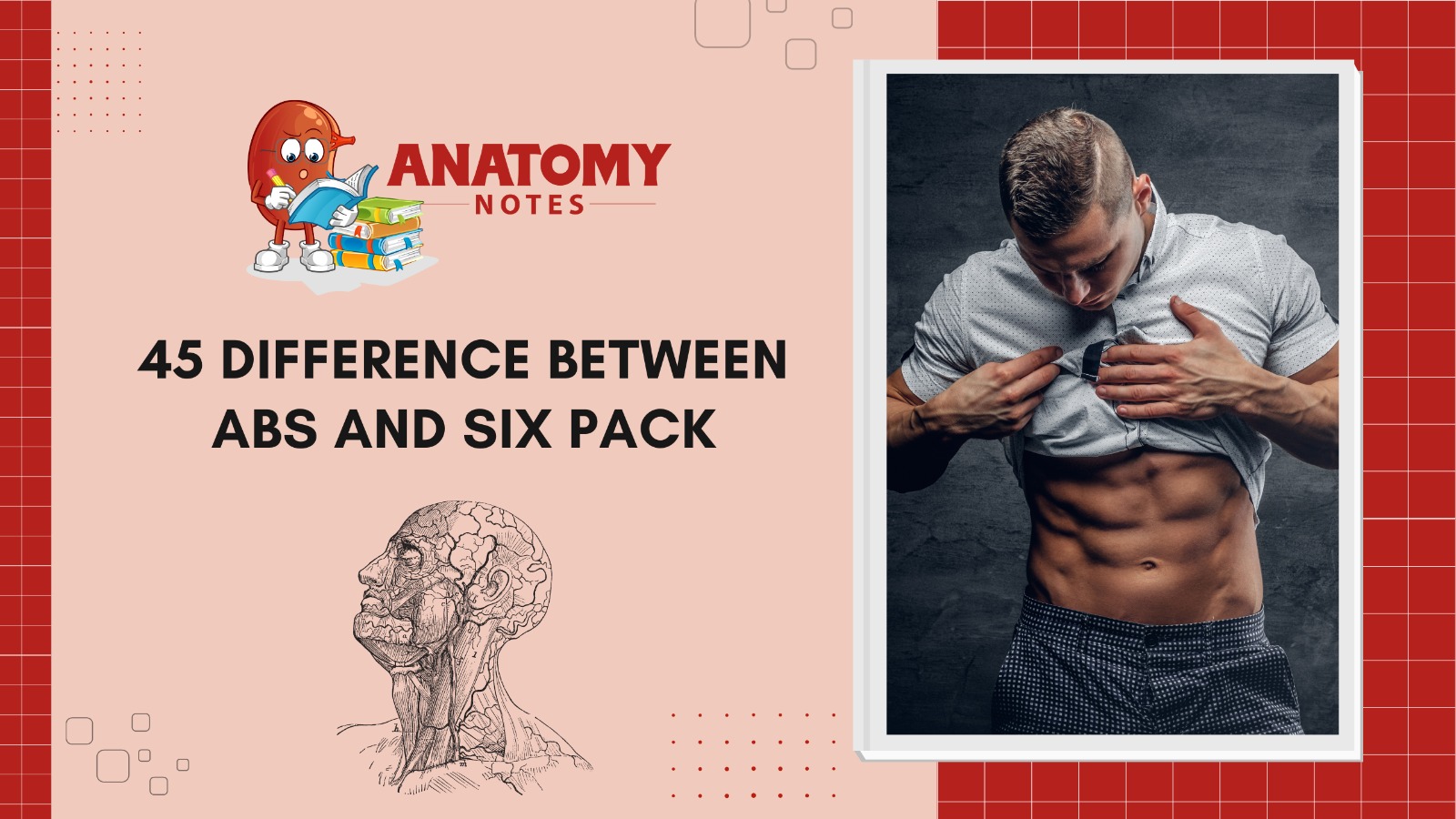“Abs” and “six-pack” are used interchangeably in fitness and body image discussions, yet they signify distinct things. Both signify a well-defined stomach, although they differ in muscle definition. Abdominal muscles, or “abs,” are front-body muscles. These muscles help stabilize the spine, balance, and move. The abdominal muscles include the transverse, rectus, and obliques. Everyone possesses abdominal muscles, but body fat determines their visibility. Low body fat makes abs visible.
A “six-pack” is a group of sculpted abdominal muscles with six muscular components. A six-pack requires low body fat and muscular abs. Focus on muscle-building activities to achieve this. Six-pack workouts include crunches, leg lifts, planks, and oblique twists. The fundamental distinction between abs and a six-pack is muscular clarity. Abdominal muscles are visible depending on body fat. However, a six-pack represents the apex of abdominal muscular development, with each part apparent even at rest.
A six-pack relies on several factors. Because too much body fat can disguise even well-developed muscles, a well-balanced diet that helps you reduce fat is vital. Calorie restriction and cardiovascular exercise lower body fat. Specific abdominal workouts strengthen and shape muscles. Remember that genes impact abs and six-pack visibility. Some people have naturally defined muscles, while others must work harder to get their desired muscularity.
In conclusion, “abs” and “six-pack” relate to abdominal muscles and a defined core, but the distinction is muscular development and visibility. If you have less body fat, you can see your abdominal muscles, whereas a six-pack is a well-defined collection of abdominal muscles. The appropriate diet, cardio, ab workouts, and genetics can achieve any aim.
|
S. No. |
Aspect |
Abs |
Six-Pack |
|
1 |
Terminology |
General term for abdominal muscles |
Specific term referring to visible muscle definition |
|
2 |
Muscle Groups |
Includes various muscles in the abdomen |
Refers to the rectus abdominis muscles |
|
3 |
Muscles Included |
Rectus abdominis, obliques, transverse abdominis, others |
Primarily focuses on the rectus abdominis |
|
4 |
Appearance |
Can range from subtle muscle definition to visible contours |
Clearly defined, chiseled muscle contours |
|
5 |
Visibility |
May not be visibly defined in everyone |
Clearly defined in a well-developed state |
|
6 |
Muscle Definition |
May have varying levels of definition |
Well-defined muscle separation and lines |
|
7 |
Fitness Goal |
Can be a goal for overall core strength |
Often a goal for aesthetic muscle definition |
|
8 |
Workouts |
Require core-strengthening exercises |
Focuses on exercises targeting the rectus abdominis |
|
9 |
Genetics Impact |
Genetics can play a role in appearance |
Genetics can influence muscle visibility |
|
10 |
Body Fat Levels |
Visible definition influenced by body fat levels |
Requires lower body fat levels for visibility |
|
11 |
Diet and Nutrition |
Balanced diet can contribute to muscle health |
Caloric balance and protein intake can impact definition |
|
12 |
Fitness Level |
Can be present in individuals with different fitness levels |
Often seen in individuals with higher fitness levels |
|
13 |
Muscle Separation |
May not have well-defined muscle separation |
Clearly visible separation between muscle segments |
|
14 |
Gender Influence |
Both genders can have varying degrees of muscle definition |
Often more prominent in males |
|
15 |
Muscle Striations |
May not exhibit prominent muscle striations |
Clear muscle striations and indentations |
|
16 |
External Appearance |
May not show through clothing |
Can be visible through clothing |
|
17 |
Training Intensity |
General core exercises may suffice |
Requires focused and targeted abdominal exercises |
|
18 |
Body Composition |
Influenced by muscle mass and body fat levels |
Highly influenced by low body fat levels |
|
19 |
Visibility Criteria |
May not meet traditional “six-pack” criteria |
Clearly visible separation of six muscle segments |
|
20 |
Aesthetic Goal |
May not be the primary goal for everyone |
Often a sought-after aesthetic goal |
|
21 |
Core Strength |
May or may not directly relate to core strength |
Visible six-pack often indicates strong core muscles |
|
22 |
Body Shape |
General term for the overall shape of the abdomen |
Focuses on the appearance of the rectus abdominis |
|
23 |
Muscle Lines |
May not exhibit defined muscle lines |
Clear vertical lines between muscle segments |
|
24 |
Visible Abs Patterns |
May not exhibit clear pattern of visible muscles |
Clear “six-pack” pattern with lines |
|
25 |
Flexing Impact |
Muscles may become more defined when flexed |
Flexing can accentuate muscle definition |
|
26 |
Advertisement Influence |
Often shown in fitness advertisements |
Frequently used in fitness marketing |
|
27 |
Confidence Impact |
May or may not impact individual confidence |
Often associated with increased confidence |
|
28 |
Athlete and Bodybuilder Focus |
Not exclusive to athletes or bodybuilders |
Often a goal for competitive athletes and bodybuilders |
|
29 |
Clothing Fit Impact |
Muscles may not impact clothing fit |
Muscles can impact how clothing fits |
|
30 |
Body Presentation |
Muscles may not be prominently shown in media |
Often showcased in media representations |
|
31 |
Age Impact |
Varies based on individual fitness and aging |
May become less visible with age |
|
32 |
Recovery Impact |
Recovery varies based on exercise intensity |
May require specific rest and recovery |
|
33 |
Muscle Group Focus |
General term for the entire abdominal region |
Focuses on a specific muscle group |
|
34 |
Vanity and Self-Image |
May not be driven by vanity or self-image |
Can be a factor in personal body image |
|
35 |
Health Impact |
Core strength can impact overall health |
Focuses more on aesthetic appearance |
|
36 |
External Perception |
May not necessarily influence how others perceive you |
Can influence perceptions of fitness and health |
|
37 |
Exercise Variation |
Requires a range of core exercises |
Requires specific exercises for rectus abdominis |
|
38 |
Muscle Depth |
May not involve deeply defined muscles |
Well-defined, prominent muscle depth |
|
39 |
Body Confidence Impact |
May not impact body confidence greatly |
Can boost body confidence when visible |
|
40 |
Exercise Consistency |
Core exercises may vary in frequency |
Requires consistent targeted exercises |
|
41 |
Athlete and Bodybuilder Influence |
Not exclusively associated with athletes or bodybuilders |
Often sought after by athletes and bodybuilders |
|
42 |
Media Influence |
May not be a primary focus in media |
Often showcased as a fitness ideal |
|
43 |
Muscle Definition Focus |
General term for varying levels of muscle definition |
Focuses on clearly defined muscle contours |
|
44 |
Social Media Influence |
May not be prominently featured on social media |
Often showcased on fitness platforms |
|
45 |
Clothing Choice Impact |
May not impact clothing choices greatly |
Can influence clothing choices and styles |
Frequently Asked Questions (FAQSremoval.
Q.1 What are abs, and how are they different from a six-pack?
Answer: Abdominal muscles support the spine and help with mobility. A six-pack is a well-defined group of abdominal muscles with distinct parts, attained by targeted training and reduced body fat. Everyone has abdominal muscles, but a six-pack is more visible and developed.
Q2. Can I get a six-pack by doing only abdominal exercises?
Targeted abdominal exercises build muscle, but a six-pack takes more than ab workouts. A balanced diet, cardio, and calorie deficit are essential for fat reduction. Combining workouts helps reduce body fat and define abdominal muscles.
Q3 Are there specific exercises that target the six-pack muscles?
Genetics, initial fitness level, food, activity, and body fat percentage affect how long it takes to get a six-pack. A well-defined six-pack takes months or years of constant labor. Patience and consistency matter.
Q4. Are there specific exercises that target the six-pack muscles?
Genetics, initial fitness level, food, activity, and body fat percentage affect how long it takes to get a six-pack. A well-defined six-pack takes months or years of constant labor. Patience and consistency matter.
Q5. Can I have a six-pack without losing weight?
Body fat % determines six-pack abs. Fat can hide well-developed abdominal muscles. Reducing body fat reveals muscles. However, naturally lean people might have prominent abs without weight reduction. A defined midsection requires muscle gain and fat removal.




